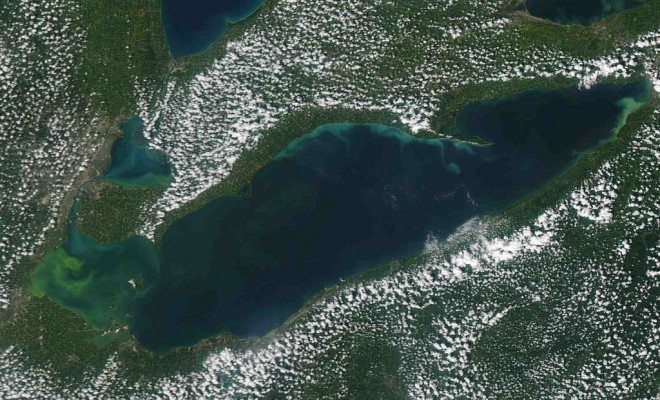
Blogs
Lake Erie Algae Bloom Raises Questions on Water Policy
We tend to envision our oceans as blue and our lands as green; the residents of Toledo, Ohio, however, had a bit difference experience recently when they were faced with green water.
When municipal officials declared they found toxins in the city’s drinking water supply, residents refrained from using it entirely. Naturally they did not drink or cook with it, but the contamination was deemed so severe that even boiling the water beforehand would not be sufficient. Emma G Fitzsimmons of The New York Times relates that children and people with weak immune systems were urged not to bathe in such water either. As local bottled supplies ran dry, the National Guard arrived to disperse fresh water.
Eventually, investigators determined that a large Lake Erie algae bloom, the source of water for the city of Toledo and 11 million residents in the lake’s vicinity, was the source of the contamination. Algae refers to a very broad spectrum of aquatic organisms ranging from the microscopic and single celled to the giant kelp of the Eastern Pacific. A bloom results in the production of a large amount of peptides, compounds consisting of multiple linked amino acids, in this case called microcystin. This particular peptide is toxic to humans, inducing vomiting, diarrhea, and liver damage, Fitzsimmons relates.

A 2012 algal bloom in Lake , courtesy of Olga Nohra via Flickr
Algal blooms resulting from human activity are often caused by massive introduction of phosphorous into an aquatic system. Lake Erie has been plagued by blooms in the past, particularly in the 1960s and 1980s. These occasions tended to be the result of poor septic infrastructure and consequent excessive discharge of waste into the lake. Since then, those threats have been somewhat ameliorated; however, agricultural runoff continues to provide undesired phosphorous discharge into water bodies such as Erie.
It is difficult to impose barriers on the leakage of phosphorous into Lake Erie. Journalist Michael Wines clarified that,
“The federal Clean Water Act is intended to limit pollution from fixed points like industrial outfalls and sewer pipes, but most of the troublesome phosphorous carried into waterways like Lake Erie is spread over thousands of square miles.”
This process is called “non-point pollution.” There have been some initiatives to try and reduce the pollution output in the first place, by providing farmers with methods of reducing fertilizer use, for example. But enacting laws that set limits on pollution is a daunting task. They must go hand in hand with voluntary efforts by those involved with the sources of pollution, to more accurately calculate how much fertilizer and materials are necessary, rather than carelessly applying an estimated amount.
An issue that must be addressed throughout the course of the dialogue on this event is the fact that algal blooms choke off other aquatic life. They absorb a massive amount of oxygen from the water, and other biodiversity are hard pressed to survive. This should be sufficient motivation in and of itself to mitigate the causes of blooms. Furthermore, substantial damage to the ecosystems of a place like Lake Erie causes fish catches to plummet, causing threats to our food supplies and commercial endeavors. The health of the lake’s biodiversity is also tied into lay fishing and other forms of recreation, which in turn brings to mind the importance of tourism and the state of the regional economy.
Simultaneously, another city farther east is also concerned with the state of its drinking water. New York City is famous for its pure and high quality drinking water. This is in large due to the vigorous efforts of organizations such as Riverkeeper, that maintain a presence in the Hudson River estuary in attempt to protect it from polluters, dumpers, and violators of other environmental and water protection laws. The source of water for more than nine million urban residents has come under threat recently from a rise in oil shipment by rail right along river’s edge in the so labeled “bomb trains,” or cars that are prone to spillage and explosion. On top of this, one of the primary aqueducts in the water infrastructure is leaking, journalists Aaron Ernst & Christof Putzel reveal. If it bursts, over half the city could be left without drinking water. In the meantime, plans are for it to be diverted through a bypass tunnel while repairs take place, which could take several years.
This case is the inverse of from Toledo; the problem is not the quality of the water, but the ability to deliver it. However, in the New York area there are many dangers to the quality of the water, and similarly the mediums by which Toledo’s water arrives in the city are an important factor when addressing phosphorous discharge and the quality of water resources. The cities face multiple and similar challenges: urban drinking water, water infrastructure, and reservoir protection. These concerns will only grow as cities expand and pressure on natural resources requires new approaches. If only two to three percent of the Earth’s water is freshwater, and the United States agricultural industry accounts for more than 75% of the nation’s water consumption, then civilian residents and policy makers face many challenges in ensuring that enough water remains drinkable and accessible to the people.
It is evident, then, that we humans are deeply entrenched in our environments. An ecosystem is very delicate, complex, and interconnected; a series of events in a remote corner may multiply and have unforeseen consequences elsewhere. It is vital for us to be more responsible in how we treat our water. We need it, the rest of the environment needs it, and we need the environment.
—
Franklin R. Halprin (@FHalprin) holds an MA in History & Environmental Politics from Rutgers University where he studied human-environmental relationships and settlement patterns in the nineteenth century Southwest. His research focuses on the influences of social and cultural factors on the development of environmental policy. Contact Franklin at staff@LawStreetMedia.com.
Featured image courtesy of [NOAA Great Lakes Environmental Research Laboratory via Flickr]









Comments